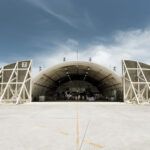A Gaza seaport: New ideas for conflict management
By Ezra Friedman | March 21, 2018

In January 2006, the radical Islamic movement Hamas won a sweeping majority in the Palestinian parliamentary elections, with an almost outright victory within the electoral districts of the Gaza Strip. This in turn led to confrontation with the secular-leaning Fatah movement, which Hamas would go on to violently eject from the Gaza Strip in 2007, leading to the current split in which Fatah retains control of the Palestinian National Authority and Palestinian Liberation Organization based in Ramallah, and the Gaza Strip is controlled solely by Hamas (which is considered a terrorist organization by Israel, the United States, and the European Union). A joint Israeli-Egyptian blockade followed Hamas’s takeover of the Gaza Strip, and has all but stopped the flow of goods and people across land, sea, and air borders. Hamas and Israel have also engaged in several rounds of conflict that have not only intensified the blockade, but have also led to massive destruction of property worth billions of dollars, including critical infrastructure. The ongoing feud between the Palestinian Authority and Hamas has led to cuts in Palestinian Authority payments to Israel for electricity in the Gaza Strip, and Hamas has raised tariffs and taxes on Gazans to generate revenue.
The Strip has become a ticking time bomb, with its almost two million residents growing increasingly desperate. However, there is potential for an improvement to both the economic and humanitarian situation in the Gaza Strip. An idea that has been discussed for more than 25 years now seems to be gaining fresh momentum: building an offshore seaport, which would be supervised by Israel along with relevant international observers, to end Gaza’s isolation while addressing Israel’s security concerns.
A dire economic situation. Gaza’s 2014 round of conflict with Israel caused $1.7 billion in losses to the enclave’s economy. The unemployment rate is over 40 percent among the general population, with youth unemployment at almost 60 percent. This in turn contributes to the low gross domestic product per person, which hovers around $1,000 a year.
In response to tunnel building and rocket production in Gaza, Israel has placed restrictions on importing construction materials and other items that could be used in a militarily offensive capacity. Tunnels are used for smuggling goods and attacking Israel, while rockets are fired at Israel’s population centers. Funds allocated for tunnel development and arms acquisition, rather than for critical infrastructure reconstruction, have further strained the economy.
Hamas’s tax levies on residents of the Strip—for everything from imports and exports to tobacco and even real estate—have supported the military effort and placed an extra burden on the people of Gaza. Limits on freedom of movement have sharply reduced per-capita income for Gazans, who have lost access to higher-paying jobs in Israel. The Gaza Strip’s economic situation is now dire and on the verge of collapse.
A deteriorating humanitarian situation. The humanitarian situation in the Gaza Strip is also dire, with 70 percent to 80 percent of Gazans reliant on some form of aid in order to survive, and tens of thousands of people still displaced as a result of the 2014 conflict with Israel. Basic public services have also seen serious deterioration—with facilities, access, and quality of services such as electricity, water, and sewage treatment all in decline or essentially nonexistent. Gazans are currently provided with a few hours of sporadic electricity a day, with fuel imports restricted by the blockade, and cuts in electricity payments to Israel ordered as part of President Mahmoud Abbas’s attempt to reassert Palestinian Authority control over Hamas. Abbas has also limited shipments of humanitarian goods that the Palestinian Authority supplies, including medicines, baby milk, and other essential commodities, all in short supply in the Strip. A lack of facilities to treat sewage, and overuse and contamination of the Strip’s only aquifer, are quickly contributing to the Gaza Strip becoming uninhabitable by 2020.
It may be in Israel’s best interest to improve conditions in Gaza—to avoid a situation in which Hamas might initiate conflict with Israel to shift the focus away from the Gaza crisis or, in a worst-case scenario, hundreds of thousands of Gazans might attempt to cross into Israel to escape the ever-deteriorating conditions. Observers have already seen an escalation in hostilities since the Trump administration’s recognition of Jerusalem as Israel’s capital in December 2017. Hamas has responded by digging new tunnels, firing rockets at Israel, and planting improvised explosive devices along the border fence. Israel, in turn, has launched air and artillery strikes, and used ground forces against Hamas positions in the form of armored and infantry units within the Gaza Strip—leading to multiple casualties on both sides over the last several months of low- to medium-level conflict.
A possible solution. One step that Israel can take to help relieve the economic and humanitarian misery is the construction of a Gaza seaport, an idea being put forward by officials including cabinet ministers Yisrael Katz and Yoav Galant. The idea for the seaport originates in the Declaration of Principles on Interim Self-Government Arrangements (the Oslo Accords) signed by Israel and the Palestinian Liberation Organization in 1993. The specifics for the seaport, such as the security arrangements and location, were to be achieved through negotiation as set out in the Gaza-Jericho Agreement of 1994. Later negotiations ran into disagreements regarding security and oversight, with the selected port location bombed during the Second Intifada and remaining unused since.
A Gaza seaport would provide for Israel’s security needs, which include a long-term ceasefire and relief of the crisis in the Gaza Strip. There are two viable options. The first option is building a seaport in either Egyptian or Israeli territory in a city that already has port infrastructure, such as El-Arish in Egypt or Ashdod in Israel, with dedicated quays for shipments to and from Gaza. Alternatively, a seaport could be constructed off Gaza’s shore.
Israel would not agree to a seaport on land within the Gaza Strip, because that could enable Hamas to import weapons for use against Israel, but a plan already exists for the construction of an artificial island roughly three miles offshore. Such an island would cost an estimated $5 billion and would be connected to the Gaza Strip by bridge. The island itself would be 1,300 acres and would have a seaport, airport, and other facilities to facilitate the movement of goods and people in a controlled environment. This would not only end Gaza’s isolation but would also satisfy Israel’s security concerns by granting Israel control of inspections on the island.
A Trump deal? Support for a Gaza seaport could manifest itself in the form of US President Donald Trump and his eagerness to broker “the ultimate deal” between the Palestinians and Israel, something that is supported by major regional powers like Saudi Arabia and Egypt. Katz proposed the plan to US Special Representative for International Negotiations Jason Greenblatt in 2017. Greenblatt and Senior Adviser to the President Jared Kushner (who is also Trump’s son-in-law) could help facilitate the necessary funding and international support, and help broker a deal that is amenable to all relevant parties. The Trump administration would need to bring together not just Hamas and Israel, but also the Palestinian Authority, Egypt, and regional states to sponsor such an agreement—which could only be achieved through indirect negotiation between Israel and Hamas.
The Trump administration’s image is damaged in the eyes of many Palestinians, and its ability to be an honest broker for both sides has been openly questioned and even denied by Hamas and the Palestinian Authority since the administration’s recognition of Jerusalem as Israel’s capital. The building of an island seaport—as one step on the path to the ultimate deal sought by the Trump administration—could go a long way toward healing the damage done to the United States’ image as a good-faith mediator, and rejuvenating the peace process.
The creation of an offshore island would have to address the needs of the population of Gaza and Hamas, allowing for sufficient increase in the flow of goods and people in and out of the Strip. It would also need to meet the security concerns of both Israel and Egypt through sufficient oversight, access, and security measures such as high-end scanning machines and sophisticated surveillance cameras. Such methods have been tried and tested in Israel and around the world, and Israeli security methods have become the gold standard.
The seaport solution would need to allow Hamas to claim some sort of political victory in the eyes of Gazans. This could be done through joint supervision of the port by Israel and relevant international observers, to ensure the steady flow of goods and people while preventing weapons from entering Gaza. The creation of such an island should facilitate a long-term ceasefire that is in the economic, political, and humanitarian interest of both Hamas and Israel.
Editor’s note: This article was initially produced for the International Student/Young Pugwash (ISYP) meeting in Astana, Kazakhstan in August 2017.
Together, we make the world safer.
The Bulletin elevates expert voices above the noise. But as an independent nonprofit organization, our operations depend on the support of readers like you. Help us continue to deliver quality journalism that holds leaders accountable. Your support of our work at any level is important. In return, we promise our coverage will be understandable, influential, vigilant, solution-oriented, and fair-minded. Together we can make a difference.














